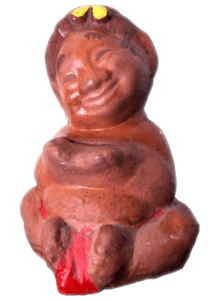Menehune


This little fellow was a promotional giveaway to encourage island children to save their pennies.
In Hawaiian mythology, the Menehune are said to be a people, sometimes described as dwarfs in size, who live in the deep forests and hidden valleys of the Hawaiian Islands, far from the eyes of normal humans. Their favorite food is the maiʻa (banana), and they also like fish.
The Menehune were said to be superb craftspeople. Legends say that the Menehune built temples (heiau), fishponds, roads, canoes, and houses. Some of these structures that Hawaiian folklore attributed to the Menehune still exist. They are said to have lived in Hawaiʻi before settlers arrived from Polynesia many centuries ago.
In Beckwith's Hawaiian Mythology, there are references to several other forest dwelling races: the Nawao, who were large-sized wild hunters descended from Lua-nuʻu, the mu people, and the wa people.[1]
Some early scholars theorized that there was a first settlement of Hawaiʻi, by settlers from the Marquesas Islands, and a second, from Tahiti. The Tahitian settlers oppressed the "commoners", the manahune in the Tahitian language, who fled to the mountains and were called Menahune. Proponents of this theory point to an 1820 census of Kauaʻi by Kaumualiʻi, the ruling Aliʻi Aimoku of the island, which listed 65 people as menehune.[2]
Folklorist Katharine Luomala believes that the legends of the Menehune are a post-European contact mythology created by adaptation of the term manahune (which by the time of the colonizing of the Hawaiian Islands by Europeans had acquired a meaning of "lowly people" or "low social status" and not diminutive in stature) to European legends of brownies.[3] '"It is claimed that "Menehune are not mentioned in pre-contact mythology, although this is unproven since it was clearly an oral mythology; the legendary "overnight" creation of the Alekoko fishpond, for example, finds its equivalent in the legend[4] about the creation of a corresponding structure on Oʻahu, which was supposedly indeed completed in a single day — not by menehune but, as a show of power, by a local aliʻi who demanded every one of his subjects to appear at the construction site and assist in building.
No physical evidence for the existence of a historical people that fits the description of the Menehune has been discovered.[5]
Structures attributed to the Menehune
- Menehune fishpond[6] wall at Niumalu, Kauaʻi
- Kīkīaola ditch at Waimea, Kauaʻi
- Necker Island structures
- Pa o ka menehune, breakwater at Kahaluʻu Bay.[7]
- Ulupo Heiau at Kailua, Oahu

Other uses
- In the experimental 1970s Aloha network developed at the University of Hawaii, the packet controllers were called Menehune, a pun on the equivalent IMP (Interface Message Processor) in the early ARPAnet. Modern Ethernet was based on the carrier sense multiple access with collision detection (CSMA/CD) methodology pioneered by ALOHAnet.
- The Menehune is the school mascot of Waimea High School on Kaua'i and Makakilo Elementary School, Maunawili Elementary School, Moanalua High School and Mililani Waena Elementary School on O'ahu.
- United Airlines used the Menehune in brand advertising for their service to Hawaii in the 1970s through the 1980s. The figurines and travel agency displays are now collectors items.[8]
- Carl Barks wrote a story featuring Scrooge McDuck helped by Menehunes, "The Menehune Mystery".
- The Menehune play a key role in the Rocket Power TV movie, Island of the Menehune.
See also
- Homo floresiensis, a presumed extinct species of very small bipedal tool bearers in the genus Homo found in the South Pacific.
- Little people (mythology)
- Nawao, another legendary Hawaiian people
- Paupueo, whose owls chase away the Menehune
Notes
- ↑ Beckwith 1970, pp. 321-323
- ↑ Joesting 1987, pp. 20-22
- ↑ Luomala 1951
- ↑ Nordhoff 1874
- ↑ p. 142, Pukui, Mary Kawena, Elbert, Samuel H., and Mookini, Esther T. Mookini. Place Names of Hawaii: Revised & Expanded Edition. Honolulu: University of Hawaii Press, 1974.
- ↑ Menehune Fishpond
- ↑ "Hoʻihoʻi Kulana Wahi pana - Restoring Sacred Places" (PDF). brochure published by Kamehameha Investment Corporation. 2008. Retrieved 2009-10-20.
- ↑ "United Airlines Menehune". Advertisingiconmuseum.org. Retrieved 2013-09-27.
References
- Beckwith, Martha (1970). Hawaiian Mythology. University of Hawaii Press. www.sacredtexts.com
- Joesting, Edward (1987) [1984]. Kauaʻi, The Separate Kingdom. Honolulu, Hawaii: University of Hawaiʻi Press and Kauaʻi Museum Association. ISBN 0-8248-1162-3.
- Luomala, Katharine (1951): "The Menehune of Polynesia and Other Mythical Little People of Oceania". Bernice P. Bishop Museum Bulletin Vol. 203; Kraus Reprint, Millwood, N.Y., 1986
- Nordhoff, Charles (1874): Northern California, Oregon and the Sandwich Islands, Chapter V, p. 80: "The Hawaiian at Home: Manners and Customs". Sampson Low, Marston, Low & Searle, London; available free online at
- Nordyke, Eleanor C. (1989). The Peopling of Hawaiʻi. University of Hawaii Press. ISBN 0-8248-1191-7.
- Schmitt, Robert C., "Early Hawaiian Statistics," The American Statistician, Vol. 35, No. 1, pages 1–3, February, 1981; (Retrieved on 2008-02-16)
External links
| Wikimedia Commons has media related to Menehune. |